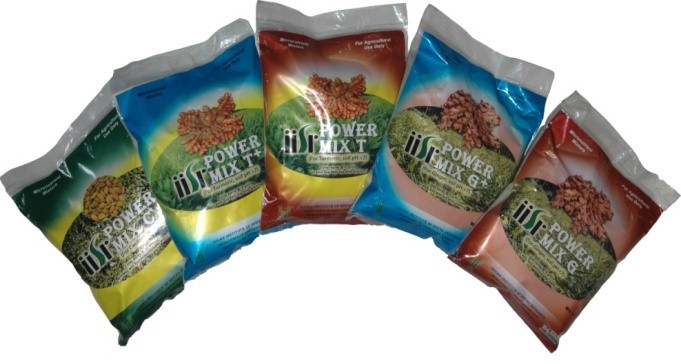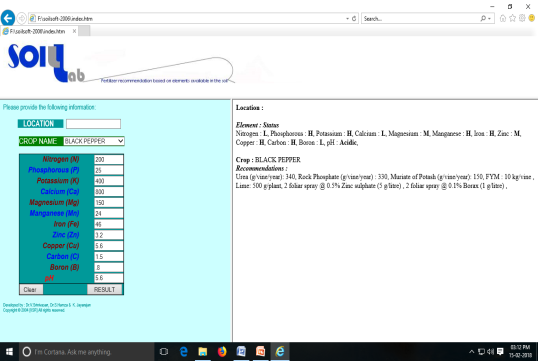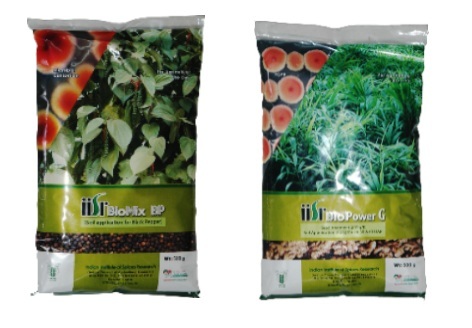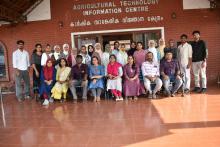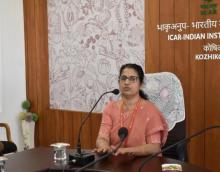Division of Crop Production and Post Harvest Technology focus on the development of suitable spice based cropping/farming systems, GIS and crop modeling based on microclimatic factors, production of quality planting material, organic farming, efficacy of biofertilizers, Integrated Plant Nutrient Management, identification of drought tolerant varieties, evaluation for high quality lines, basic studies on the biosynthesis of secondary metabolites, characterization of bioactive principles in spices and post harvest processing techniques in spices.
1. Climate analysis and Phenology
- Crop-weather relationships of black pepper and turmeric were quantified and weather based models for yield prediction has been developed.
- Phenology of ginger and turmeric has been worked out.
- Leaf area estimation model for black pepperand ginger has been developed.
- Mapped efficient spice producing zones. Climate analogue sites were identified for spices.
- Rainfall trend analysis at IISR Stations and major spice producing zones were done.
2. Planting material Production
- Efficient black pepper propagation techniques have been standardized.
- Annually 1.0 lakh black pepper rooted cuttings, 2.0tonnes of ginger and 4.0 tonnes of turmeric seed rhizome multiplied and distributed every year.
3. Soil Nutrient Management
Black Pepper
Basic research
- The Diagnosis and Recommendation Integrated System (DRIS) was used for developing foliar diagnostic norms for black pepper. The nutritional survey carried out in 578 black pepper gardens covering major pepper growing areas of Kerala and Karnataka states indicated that 63.6 per cent of the vines were high yielders. An optimum yield ranging from 561 to 4526 g per vine can be realized provided the youngest matured leaf contains 1.65 to 2.79 per cent N, 0.11 to 0.26 per cent P, 0.18 to 2.84 per cent K, 1.42 to 3.33 per cent Ca, 0.40 to 0.60 per cent Mg, 0.09 to 0.29 per cent S, 126 to 1145 ppm Fe, 109 to 721 ppm Mn, 21 to 67 ppm Zn and 16 to 120 ppm Cu.
- The statistical relationship between the various nutrients in the soil, leaf and yield of pepper was studied. The soil pH was negatively correlated with soil Fe (r=0.27**), soil Mn (r=0.478**) and soil Al (r=0.205*). The leaf N was correlated with leaf Mo (r=0.223*) and soil Zn (r=0.272*). The leaf K was negatively correlated with leaf Al (r=0.293**) and leaf Mg (r=0.204*). There was a significant positive correlation of pepper yield with leaf N(r=0.204*) leaf K (r=0.193*), leaf Mo (r= 0.312**), soil Cu (r=0.225*), soil Fe (r=0.220*) and soil Mn (r=0.290**).
Applied research
- In lateritic soils, application of 140 g N, 55g P2O5 and 270 g K2O/vine/year is optimum. Basal application of P with the onset of monsoon and N and K in two equal split during June and September are optimum. Inclusion of micronutrients like zinc, boron and molybdenum @ 5:2:1 kg ha-1 respectively in the fertilizer schedule enhanced yield and quality. Similarly sound soil management practices enhanced the productivity of spices. Basal soil application of 6 kg Zn and 1.0 kg Mo for higher yield and quality of black pepper under deficient conditions. Based on multi location studies at farmers field’s in northern districts of Kerala, foliar application of Zn (0.25%) twice, once in June and in Aug is recommended for increasing the yield.Forhigher yield and fertility buildup in black pepper gardens, Coir pith compost can be recommended @ 1.25 t ha-1 integrating with ½ the recommended fertilizer dose and Azospirillum sp. @20g vine-1for increased yield by 25% and the BC ratio to 1.79.
- Organic farming package: For black pepper 10 kg FYM + 500g Neem cake + 500 g Ash+ 2 kg vermicompost with Biofertilizers – Azospirillum and P solubilizing bacteria(20g) application for its nutrient requirement and Trichoderma (50g) and Pseudomonas (IISR 6) (50 g) per vine and spray of 1% Bordeaux mixture (BM) and neem oil (5 mL L-1) for disease and pest control has been tested and demonstrated.
- A technology package for sustaining the health and yield of virus infected (Mild & moderately affected) black pepper vines including application of FYM (10-15 kg per standard), site specific NPK application, foliar application of micronutrient @ 5g/L twice and application of black pepper PGPR consortia – twice, has been standardized.
Ginger
Basic research
- Critical range of soil Zn, leaf Zn and P/Zn ratio were standardized for major spices like ginger and turmeric for correcting the deficiency and scheduling fertilizer recommendation. The critical range of leaf P/Zn ratio was found to be 27.9 to 90 and that of soil is 1.03 to 6.21 through Mitscherlich model.
- Developed targeted yield equation as N= (Y*100*0.075) - (STV*0.88); P2O5 = (Y*100*0.014) - (STV*1.49); K2O = (Y*100*0.025) - (STV*0.23) on validation for yield targets of 25, 35 & 45 kg/bed levels could predict successfully with a positive deviation of 15.7 – 70.0% in yield at varying soil fertility levels at Coorg District of Karnataka. The economic optimum was found to be Rs. 3.75/ bed for N, Rs. 1.30/ bed for P and Rs. 0.60/bed for K.
Applied research
- INM in ginger: Application of neem cake @ 2 t ha-1 with NPK @ 75, 50, 50 kg ha-1 together with micronutrients (5 kg Zn, 2 kg B and 1 kg Mo each ha-1) enhanced oils and oleoresin in production.
- Organic package: 20 t FYM + 2 t Neem cake + 1 t Ash + 4 t vermicompost/ha, Azospirillum and P- Solubilising bacteria (20 g/bed) for nutrient supplement, GRB 35 as seed treatment has been standardized. Drench of PGPR consortia or GRB 35 or Trichoderma are helpful in keeping the disease incidence <10-15% in ginger. Application of BM (1%) spray to contain foliar diseases and neem oil (5 ml/ lit) in combination with the cultural control is recommended for shoot borer. Organic management system yielded on par with integrated systems and quality was found to be superior under organic systems.
Turmeric
Basic Research
- Developed targeted yield equations, to calculate nutrient requirement for fixed yield targets in soils with varying fertility levels. developed targeted yield equation as N= (Y*100*0.03) - (STV*0.42); P2O5 = (Y*100*0.016) - (STV*3.84); K2O = (Y*100*0.073) - (STV*0.73) and on validation nutrient requirement for 15 & 20 kg/bed yield could be predicted with minimum deviation of -5.8 to +14.8% in yield with 2-50% increased yield over recommended dose at varying soil fertility levels at Wayanad and Calicut Districts of Kerala. The economic optimum was found to be Rs. 0.65/ bed for N, Rs. 0.40/ bed for P and Rs. 0.85/bed for K.
- The response function of NPK for turmeric (var. Suvarna) was worked out as
Yield = 2346 + 54.8 N - 0.450 N2 (R2=0.981)
Yield = 2346 + 65.8 P - 0.5832 P2 (R2=0.981)
Yield = 2346 + 27.4 K - 0.10 K2 (R2=0.981) and the optimum level was standardized at NPK @ 60: 50: 120 kg/ha.
Applied research
- Field experiments with four varieties of turmeric viz., Suvarna, Suguna, Sudarshana and Alleppey with four levels of NPK fertilizers and two levels of micronutrients, under rainfed conditions showed that variety Alleppey followed by Sudarshana and Suguna were superior with regard to yield of rhizome, curcumin recovery and economics and these were significantly increased due to application of NPK and micronutrients. NPK @ 60, 50, 120 kg ha-1 with micronutrient was optimum for the varieties Suvarna, Suguna and Alleppey, whereas for Sudarshana 50, 40, 100 kg ha-1 with micronutrients was optimum.
- Organic package: 20 t FYM + 2 t Neem cake + 1 t Ash + 4 t vermicompost/ha, Azospirillum and P- Solubilising bacteria (20 g/bed) for nutrient supplement, GRB 35 as seed treatment has been standardized. Drench of PGPR consortia or GRB 35 or Trichoderma are helpful in keeping the disease incidence < 5 %. Application of BM (1%) spray to contain foliar diseases and neem oil (5 ml/ lit) in combination with the cultural control is recommended for shoot borer. Organic management system yielded on par with integrated systems and quality was found to be superior under organic systems.
Cardamom
Basic Research
- Characterized the soil fertility of cardamom growing tracts of South India and delineated 74, 54, 50, 46, 43, 41 and 38% leaf samples as low in Zn, K, P, Ca, Mg, Cu and Mo, respectively with the yield limiting nutrients in the order of Zn> K > P > Ca > Mg > Cu > Mo > Fe >Mn>N.Soil available P, K, Cu and leaf Cu were significantly positively correlated with cardamom yield.
- Standardized the foliar DRIS norms for cardamombased on tissue analysis and yield data. For optimizing yield between 131 to 625 kg (dry) capsules/ha the index leaves (fifth pair from the terminal) should have nutrient concentration of 1.26 to 2.81% N, 0.10 to 0.20% P, 1.1 to 3.4% K, 0.51 to 1.38% Ca, 0.18 to 0.31% Mg, 135to 370 ppm Fe, 261 to 480 ppm Mn, 20 to 45ppm Zn, 10 to 46ppm Cu and 0.28 and 0.84 ppm molybdenum.
Applied Research
- For cardamom, application of MRP @ 75 kg P2O5 ha-1 year-1 was economical. For high density planting of cardamom (2 x 1m), application of NPK @ 120:120:240 kg ha-1 and for normal spacing (2 x 2m) @ 75:75:150 were optimum. Application of neem cake (2.9 t/ha) or vermicompost (@ 15 t/ha) produced 52% increase in yield of cardamom over NPK alone.
- Organic manures for cardamom: In cardamom, neem cake was found to be the best organic nutrient supplement on par with vermicompost, recording highest yield of 1.13 kg dry capsules/clump with highest B/C ratio of 19.6. Quality parameters were high in FYM and vermicompost applications.
Tree Spices
- For Tree spices like Clove, Nutmeg and Cinnamon application of P as MRP @ 250 g P2O5 tree-1 year-1 with 25 kg of FYM besides application of N and K @ 300 and 1000 g P2O5 tree-1 year-1 was optimum for sustained productivity.
Medium for Nursery Mixtures
- Coir pith compost (Terra care) can be successfully substituted for soil or sand in conventional nursery mixture (Soil: sand: FYM 1:1:1 ratio) and fortifying the soil: coir compost mixture in 80:20 ratio (w/w) with small quantity of diammonium phosphate can also replace sand /FYM in nursery mixture in spices (black pepper) nursery.
- Soil: sand: coir dust: vermicompost (1:1:1:1) that supports seed germination and seedling growth as better medium for nutmeg in nursery.
- Developed integrated nutrient management for paprika alike chillies under polyhouse conditions with application of 75% N (8 g plant-1) + Azospirillum spp. (5 g plant-1) + 75% P (1.7 g plant-1) + Phosphobacteria (5 g plant-1) + 100% K (2.5 g plant-1) for improved the growth, yield and quality parameters.
- Worked out the C budgeting, C footprint and sustainability of the agricultural production system in India and sustainability index of the system. An increase of 1 Tg/ yr of C input has resulted in a corresponding increase in C output of 20.6 Tg/yrand C output – input ratio and sustainability index decreased during 2000-2009 as compared to pre green revolution period
4. Physiology of spices
Black pepper
- Characterised drought tolerance and screened about 1000 germplasm accessions for drought tolerance based on characterised parameters
- Studied the physiological, biochemical and molecular mechanisms of drought tolerance
- Climatic parameters affecting black pepper production in different growing regions of the country has been studied
- Studied the impact of climate change on growth, productivity and quality in black pepper
- Identified the physiological and biochemical factors controlling productivity which helps to identify the probable high yielders in juvenile stage itself
- Reasons for alternate bearing habit of black pepper has been studied and solution to minimise alternate bearing habit has been worked out.
- Physiology of black pepper vines affected by viral diseases especially CMV and badna has been investigated
- Technology for high productivity with summer irrigation and early shade regulation during May II fortnight for proper light distribution to initiate flowering has been standardized
- Physiological and molecular mechanisms underlying viral diseases and management strategies to contain the diseases have been developed
- Photosynthetic factors controlling growth has been studied
Ginger
- Characterized the parameters for drought tolerance
- Source sink relationship, dry matter partitioning and rhizome bulking stages have been characterized
- Climatic influence on source-sink relationship is being studied
- Fertigation schedule has been developed
- Soil less cultivation of ginger under fertigation has been standardized
- Growth, physiology, partitioning and quality of ginger grown under different coloured shadenets has been studied
Turmeric
- Source sink relationship, dry matter partitioning and rhizome bulking stages have been characterised
- Climatic influence on source-sink relationship is being studied
- Growth, physiology, partitioning and quality of turmeric grown under different coloured shadenets has been studied
Nutmeg
- Identified the resistant root stock for drought tolerance which can be used in root stock breeding for enhanced productivity under drought
- Technology for splitting the mature fruits by harvesting pre split physiologically mature fruits using ethereal has been developed which avoids soil contact of fruits thus helps to prevent aflatoxin contamination in nutmeg.
- Studied the comparative physiology of orthotropic and plagiotropic shoots
- Studies on inducing synchronous flowering is in progress
5. Value addition in spices
- A concentrated solar thermal curing unit of capacity 50 kg/ batch for turmeric cooking was set up at IISR Experimental Farm Peruvannamuzhi. Burning of firewood is completely eliminated in the unit and hence there is no release of carbon to the environment and thus improves the working environment in a turmeric field.
- An Agro Processing Centre for Spices for primary processing, cleaning and grading of black pepper and cardamom was established at IISR Regional Station at Appangala, Karnataka
- A Spice Processing Facility which serves as an incubation centre for spice entrepreneurs was established at ICAR-IISR, Experimental Farm Peruvannamuzhi. The facility has a black pepper cleaning unit, curry powder production unit and a white pepper production unit.
- A prototype mechanical unit for the production of white pepper from green pepper in a very hygienic manner was developed.
6. Chemistry of spices
- High quality accessions of cardamom, ginger and turmeric were identified. Eleven Cinnamomum species were characterized based on leaf volatile constituents. In Cinnamomumverum three new chemotypes were identified based on essential oil composition of leaf and bark.
- Essential oil constituents of Myristicafragrans, M. beddomei, and M. malabaricahave been identified. Modified HPLC method was standardised for the quantification of individual curcuminoids in turmeric.
- Fungitoxic principles in allspice leaf oil and Chromolaenaodorata leaves were characterized. Flavones and triterpenes from leaves of Piper colubrinum leaves, Humboldtiavahliana, Mussaendafrondosa and fruit pericarp of Artocarpusheterophyllus were characterized.
- Nematicidal principles in Strychnosnuxvomica, scented geranium and allspice were characterized. Hand-held electronic nose was developed in collaboration with C-DAC, Kolkata, for determining the oil content in cardamom.
7. High Value compounds from spices
- Antioxidant activities of different spices extract were studied
- In vitro hypoglycemic activities of different spices extracts were studied and cinnamon extract were found to have maximum inhibitory activity against alpha amylase and alpha glucosidase enzyme
- In vivo hypoglycemic potential of cinnamon and turmeric extracts were studied using albino wistar rat model and found that these extracts reduced the blood glucose level of diabetic` rats.
- Experiments were conducted to increase the solubility and absorbability of curcumin in different vegetable oils was tried.


